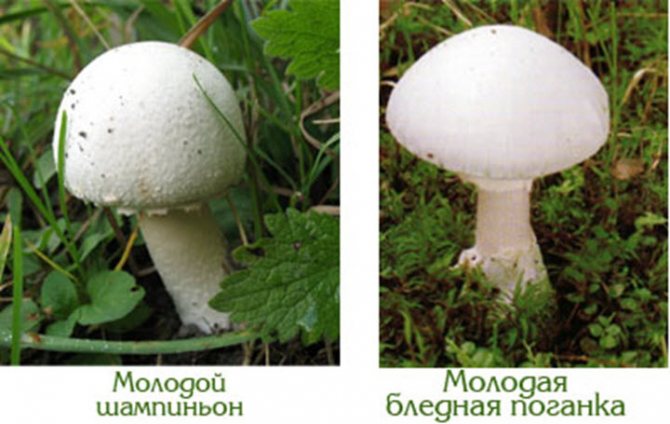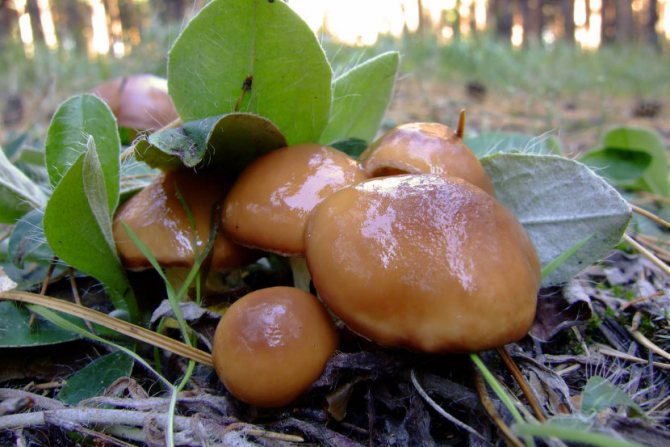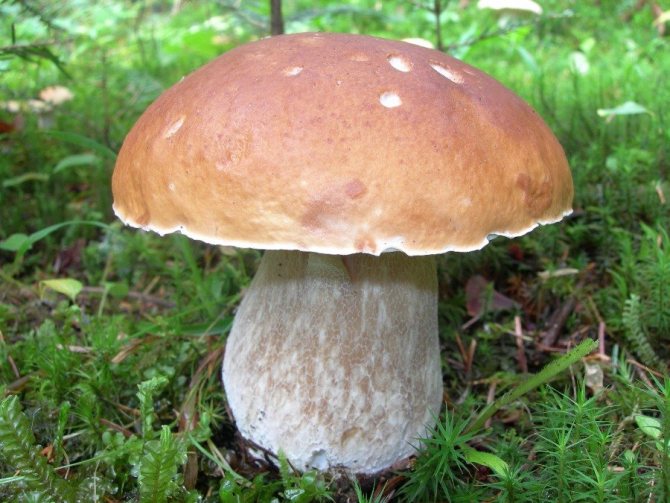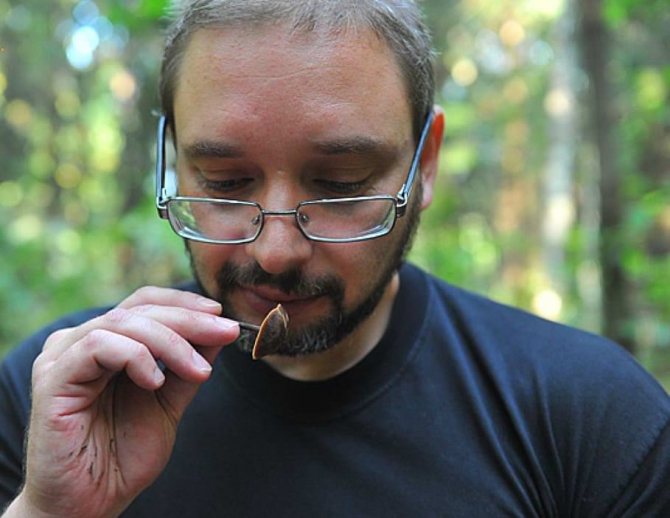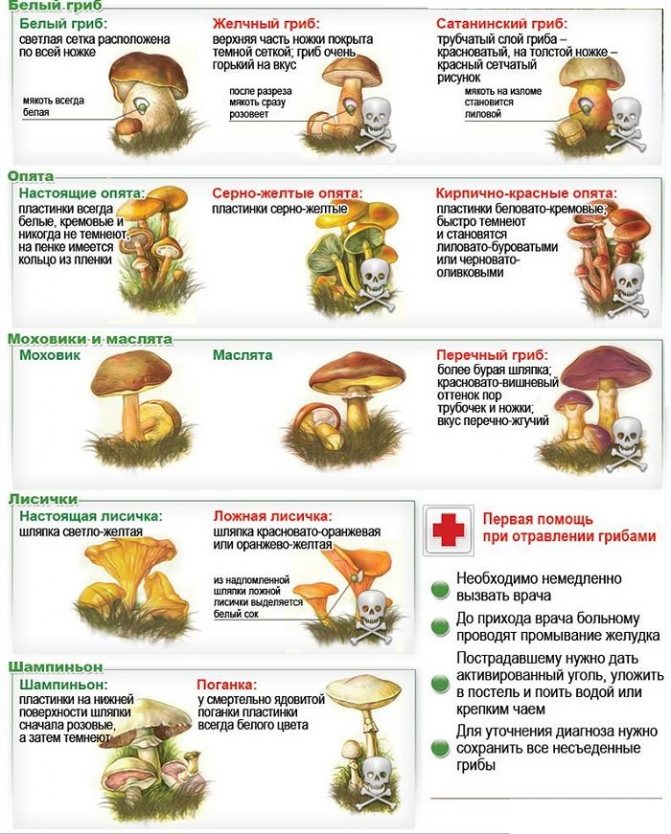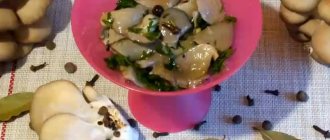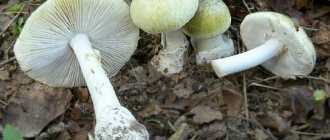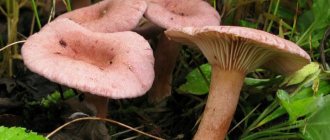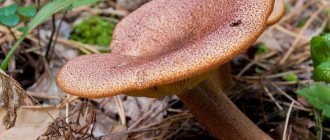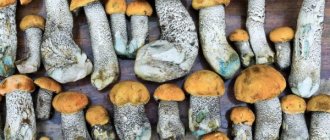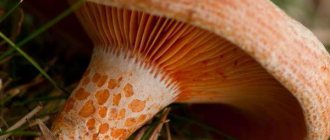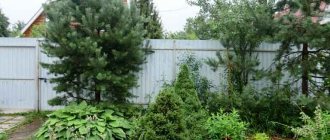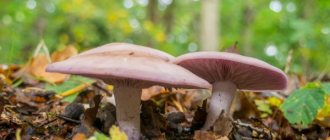»Mushrooms» Signs of dangerous cepes doubles
0
347
Article rating
Among lovers of "quiet hunting" the porcini mushroom with its unique aroma and nutty taste is especially appreciated. Often, instead of edibles, false, poisonous specimens, the use of which are life-threatening, fall into the basket. To prevent the dangerous double of the porcini mushroom from getting into the basket, you need to know its characteristic features.
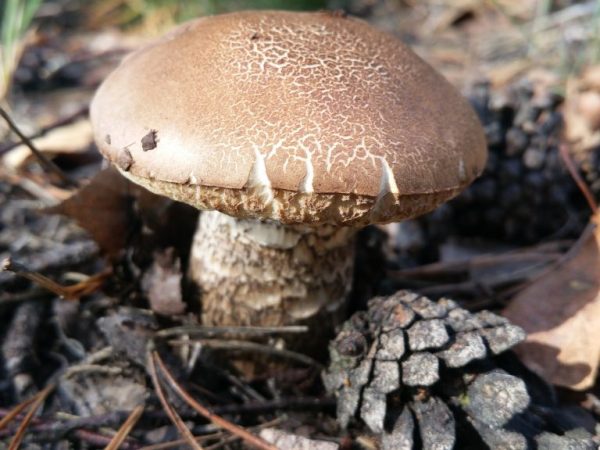
Signs of dangerous cepes' twins
How to check mushrooms for edibility and toxicity: myths and reality
Many mushroom lovers have to be content with only purchased ones, since not everyone knows how to identify poisonous specimens and distinguish them from edible ones. Of course, banal logic will not allow cutting an acid-green sample into a lilac speck, but many poisonous species look like quite edible ones.
Moreover, there are a lot of misconceptions about how to test mushrooms for toxicity. To refute most of them, experts argue that there are no simple ways to determine the toxicity of a fungus. Many species react differently to the same techniques and it is very easy to get poisoned by the seemingly edible product.
This article will look at some of the most common false methods for identifying poisonous species at home.
Myth 1: young is edible. All mushrooms can be eaten while they are young. It is understood that the poison appears in them only over time.
Reality: absurd delusion. For example, the pale grebe is poisonous at any age. It is best to study the mushroom encyclopedia and know the edible species "by sight". At the slightest doubt about the suitability of the foundling as food, it is worth throwing it away. This is not a case where the risk can be justified.
Phalloidin is one of the most dangerous mushroom poisons. Most of all, it is contained in the pale toadstool. By the strength of the adverse effect on the human body, phalloidin is equivalent to snake venom. An adult pale toadstool contains 10 mg of this substance, and when a person uses 20 mg, 98% of cases end in death.
Myth 2: silver. If a silver object is immersed in water during cooking, it will turn black, indicating that there are poisonous among the products.
Reality: Amino acids, which contain sulfur, cause silver to turn black. But this substance is present not only in poisonous, but also in edible species. There is even a separate subspecies of poisonous mushrooms, which such a method will not reveal. It follows from this that this method is not at all valuable.
Myth 3: onions and garlic. While boiling mushrooms, throw onions or garlic into the water. In the case of the presence of poisonous mushrooms in the container, the heads of the root crops will turn black.
Reality: it is useless to check the toxicity of mushrooms with onions or garlic during cooking. The color change of onion or garlic during cooking to brown occurs due to the tyrosinase pigment. It is found in both poisonous and edible mushrooms. May cause food poisoning if ingested.
Myth 4: boil. If fresh mushrooms are boiled for several hours, they will lose all their toxicity.
Reality: most of the poisons in mushrooms are heat-resistant and are not afraid of heat treatment.
Myth 5: sour milk. If you put mushrooms in fresh homemade milk for a while, it will turn sour.
Reality: Enzymes like pepsin and organic acids make milk sour. These enzymes are found in edible, inedible, and poisonous mushrooms.
Myth 6: bad smell. Poisonous mushrooms have a strong unpleasant odor.
Reality: smell is an integral part of any mushroom. Only novice mushroom pickers will believe that poisonous mushrooms have a specific disgusting smell, and that edible ones smell acceptable. This argument is not worth a dime. For example, champignon smells exactly like the eerily poisonous pale toadstool. In addition, not all people have a keen sense of smell and are generally able to distinguish the subtleties of mushroom aromas.
Myth 7: pests. Worms, insects and snails do not eat poisonous mushrooms. If there are traces on the mushroom, indicating that some forest dweller has already eaten it, then it is edible.
Reality: nothing more than just another bike that exists among beginners. Larvae, insects, snails and other small living creatures can spoil a poisonous mushroom with their appetite. Chanterelles and a Polish mushroom remain inviolable.
Myth 8: alcohol is a panacea. In case of mushroom poisoning, alcohol will help.
Reality: one of the most dangerous misconceptions. A high-grade drink will not help, but will greatly aggravate the condition of a person who has eaten poisonous mushrooms. Alcohol-containing substances provoke the accelerated spread of toxic substances in the human body, therefore, they will only accelerate the effect of the poison.
Myth 9: taste good. If the mushroom is tasty, it is not poisonous. Many mushroom pickers try raw mushrooms when picking. If it tastes bitter, it is poisonous. At the same time, it is believed that the minimum amount of poison that gets into the body during tasting with saliva will not cause significant harm.
Reality: there are clearly poisonous mushrooms without bitterness with a very pleasant taste:
- death cap;
- poisonous entoloma;
- red and panther fly agaric;
- many other types.
Myth 10: pink records. Pink plates under the cap of the mushroom indicate its edibility.
Reality: indeed, young champignons also have pink plates, like poisonous mushrooms, so this is far from an indicator.
Myth 11: terrain. Poisonous mushrooms do not grow in open areas, but only in forests.
Reality: completely unfounded delusion. Numerous cases of poisoning by mushrooms collected in meadows are known.
Myth 12: the color of the rift. When the cap breaks, the blue, pinkish or reddened flesh symbolizes the unfavorableness of the find. White, gray, beige and other shades that have not reacted to the oxygen of the pulp indicate edibility.
Reality: At the rift, many edible species turn blue or change color:
There are certain types of mushrooms - partially unusable. They need to be boiled for a long time in a special mixture of vinegar and salt, and then when frying they will already be quite edible. But this method does not apply to all unfavorable specimens.
In the absence of the skill to distinguish edible mushrooms from unsuitable for food, it is better not to collect, but to buy them.
Summer honey mushroom, description and photo
Summer mushrooms are representatives of the Kingdom of Mushrooms, united in the Strofariev family. Like any mushroom, the species in question has its own special external characteristics.
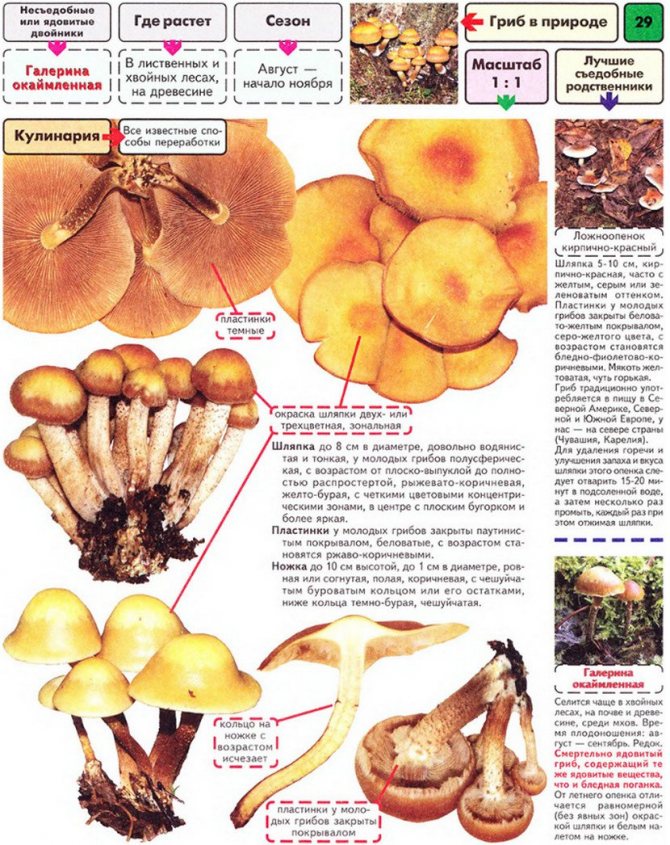

Botanical description of the summer honey agaric:
- Hat. The size can vary from 20 to 80 mm. It is highlighted in yellow with a brown tint. The hat can change its color depending on the moisture level. In the central part, a convex tubercle is noticeable, and closer to the edge, the surface is flatter. The pulp is quite thin and watery, of a light brown color, which becomes darker at the cut. The upper part of the fruiting body has a woody aroma and a pleasant aftertaste.
- Plates. These fragments of the cap are distinguished by a pale yellow color, and closer to the stem they turn into a reddish-brown hue. The plates are poorly attached to the stem.
- Disputes. They are dark brown powder. Sometimes you can see that the lower tier mushrooms are covered with brown spores produced by the "upper" mushrooms. Therefore, many inexperienced mushroom pickers are mistaken, thinking that the accumulation of mushrooms has rotted.
- Leg. The length of this part of the mushroom is 30–80 mm, and the diameter is 5 mm. The slightly curved light brown leg, the lower part of which is painted in a dark brown color, has a cylindrical shape with a brown filmy circle under the plates. The flesh is much darker and denser than the cap.
The appearance of the fruit body in question can be examined in detail in the photo.
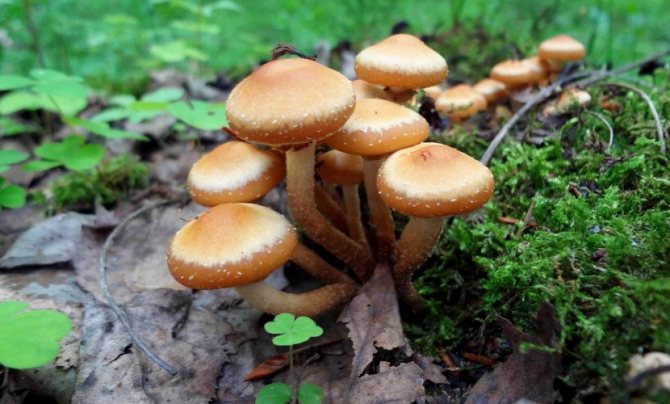

The species in question can also be identified by other characteristics.
- Spread. This mushroom usually grows from early summer to mid-autumn (June – October). The largest amount is harvested in July-August. These mushrooms grow on stumps, as well as in damp or rotten wood. It is quite difficult to meet summer mushrooms on conifers.
- Edibility. Summer, like other species of honey agarics, are conditionally edible. This means that they can only be used boiled and pickled. In a raw state, such mushrooms cannot be used as food raw materials.
Many mushroom pickers notice that an aggressive mosquito swarm is invariably present over these mushrooms during the collection of summer mushrooms.
Video: Summer honey mushroom
How to check if the mushroom is poisonous or not, at home?
Now we will tell you how to check if mushrooms are poisonous. There are different ways. We'll look at them. They will be useful for housewives and mushroom pickers.
Even on a dreary cloudy day, the forest looks unusually beautiful. A slow walk along it will help you to forget about the daily hustle and bustle for a while and immerse yourself in the magical atmosphere of wild nature. He is generous in his gifts - picking berries and mushrooms brings not only pleasure, but also benefits, because many villagers go through harsh winters thanks to the reserves they make from early spring to late autumn. The townspeople go to the forest more often for recreation, so not everyone knows well how to distinguish a poisonous mushroom from an edible one.
Read also: Talking mushrooms: a description of how to distinguish from false, cook, gray, edible, poisonous, inedible, photo, video
How to distinguish doubles?
Edible mushrooms, which are hunted by mushroom pickers, have counterparts - inedible, conditionally edible, or poisonous. Here are the most famous pretenders:
- Bile and satanic mushroom. These are doubles of boletus - the most valuable representative of the mushroom kingdom. But distinguishing doubles is as easy as shelling pears. The first has a dark mesh of veins on the leg, the second has a reddish one. You can also cut off a piece of the leg to see if its color changes. If after a minute the color of the cut does not change, the boletus can be put in the basket. In doubles, the color from white will change to pink - in the bile, and purple - in the satanic mushroom.
- False boletus. His hat is darker than the real one. The color of the cut of the leg does not change, but in a real redhead, on the contrary, it darkens.
- False boletus. It can be distinguished from an edible mushroom by a darker cap and a bluish cut. Another sure sign is the place of growth. False boletuses do not grow under birches.
- False chanterelles. To distinguish them from edibles, you need to be careful. Look at the color of the hats. In real chanterelles, they are light orange, almost yellow. False specimens are bright orange in color, and when broken, drops of white juice appear.
- False mushrooms. There are many poisonous and inedible mushrooms that look like honey mushrooms. Real mushrooms from false ones can be distinguished by a brownish or brownish-yellow scaly cap. Moreover, the caps are pale, in the false ones they are bright, for example, red-brown or rusty-red.Edible honey mushroom can also be identified by its smell - it has a pleasant and rich mushroom spirit. False gather give off the smell of mildew and damp earth.
How not to get poisoned?
A variety of mushroom dishes are found in almost all cuisines of the world. However, you should not engage in independent gathering if you are not sure of the accuracy of your knowledge and the ability to distinguish edible from poisonous. Observing the period (1 day) and storage conditions (in a cool place without direct sunlight). you can safely cook a delicious product.
Advice: mushrooms are not cooked or stored in aluminum, zinc, ceramic dishes with glaze in order to avoid oxidation or the reaction of certain substances contained in them with the material of the dishes.
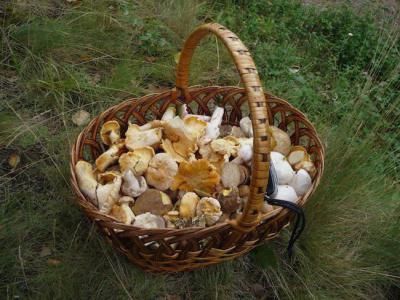

A careful attitude to quiet hunting, as mushroom pickers call the collection of gifts from nature, will help to avoid poisoning. Take only those that you know well. Do not pick mushrooms near a highway, railroad track or industrial plant.
You have come from the forest, you feel pleasantly tired, and on the table only collected mushrooms, enticing with a smell, are waiting to be processed. And then you realize that you are not sure that they can be eaten. And how to check if the mushroom is poisonous or not, at home? There are many ways to do this. But, unfortunately, it is reliably impossible to determine whether there is a poisonous one among the collected mushrooms.
Here are some options to help you check. We will also consider myths in parallel.
Why is self-checking dangerous?
One of the most dangerous is the mushroom poison phalloidin, which is found in large quantities in the pulp of the pale toadstool. The strength of the effect of this toxin on the human body is comparable to that of snake venom, and for a lethal outcome, it is enough to consume only a few grams of the fruiting body.
It should also be remembered that mushroom dishes are very hard food for the body and people with liver, kidney, gastrointestinal tract diseases, hypertension and metabolic disorders may experience some problems after eating them. It is strictly forbidden to cook and store cooked mushrooms in aluminum, zinc or ceramic, glazed pans, since in such containers the fruit bodies completely lose their edibility. It is important to remember that "quiet hunting" is not at all a safe activity, therefore, when collecting them, you need to be extremely careful and attentive.
Silver and garlic
How to check if a mushroom is poisonous or not? It is said that a silver object can be dipped into a saucepan with this product. And in the event that the silver darkens, it means that there is a poisonous mushroom there. But this theory is not 100% correct. Since a reaction can occur with a substance that is released from the edible mushrooms.
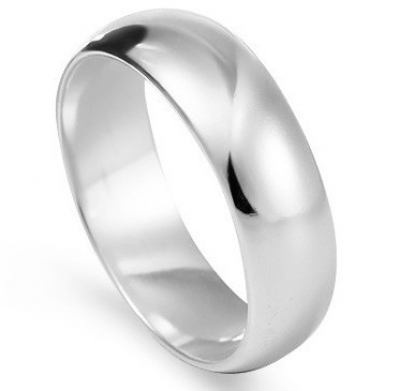

The altered color of the garlic added during cooking also does not one hundred percent confirm the presence of dangerous stalks. After all, there could be, again, a reaction with the tyrosinase enzyme.
It is believed that insects do not even sit on poisonous mushrooms. This is not entirely true. Some sit down and even eat them. It's just that there are insects in nature that are resistant to poison.
How to check if mushrooms are poisonous when cooking?
You can use the following folk method. You only need an onion. So how do you check for poisonous mushrooms? When cooking these foods, place halved onions in a saucepan. If the vegetable turns blue, then the mushrooms need to be thrown away, as they are poisonous. Such products can be seriously poisoned.


How to check if a mushroom is poisonous or not? As you can see from the many verification methods, it is difficult to reliably know about this. Remember that the use of such anti-scientific methods can be fatal!
Other names
Due to its characteristics, the honey honey agar has received other names of both Latin and Russian origin.
The considered species of mushrooms has the following scientific names:
- Agaricus mutabilis Schaeff;
- Pholiota mutabilis (Schaeff.);
- Dryophila mutabilis (Schaeff.);
- Galerina mutabilis (Schaeff.).
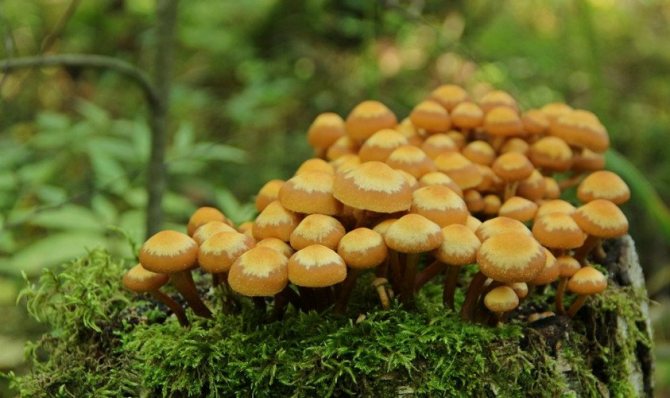

In the Russian language, the following variants of the names of this type of honey agarics "took root".
- Talker. The etymology of this word can be found in the dictionary of V. I. Dahl, where it is indicated that part of the word - "dialect" can mean a blister or a bubble. This is due to the shape of the cap in its central part, and looks like a tubercle or blister.
- Lime. This name is associated with the location of the summer honey agaric. Often you can find the considered type of mushroom on wet linden wood.
- Volatile. This name is associated with the hygrophilous property of the honey fungus. In dry weather, the cap turns pale, losing its specific characteristics, so it is often confused with other mushrooms. With sufficient humidity, the color of the cap becomes two-colored: in young ones it is yellow-brown, in old ones it is brown-orange.
Did you know? Among the people you can hear another unusual name for the summer mushroom
—
"Varushka". It is believed that this name comes from the word "cook". This confirms the fact that the mushroom in question should be eaten boiled.
How to provide first aid for mushroom poisoning?
If, nevertheless, trouble has happened, you need to immediately contact a medical institution by calling an ambulance. Before the ambulance arrives, your actions can not only alleviate the suffering of the victim, but also save his life. Act clearly and quickly:


- Don't panic.
- Perform a gastric lavage and induce vomiting several times.
- The victim should be placed comfortably in a horizontal position and covered with a blanket.
- Drinking drinks regularly will help prevent dehydration and fight toxins. To do this, you need to drink milk, salted or just clean water.
- There must be someone constantly near the patient to ensure that the victim is conscious, and to sniff ammonia in case of loss of consciousness, otherwise a coma may occur.
How to check mushrooms for edibility using folk methods, and is it dangerous
Delicious pickled mushrooms, white mushrooms, fried in sour cream, rich mushroom soup - the number of dishes with mushrooms is innumerable. Many people prefer to pick mushrooms on their own for home cooking, because it is not only profitable, but also a pleasant pastime. However, such an activity can have unpleasant consequences if you do not know all the intricacies of the process. We will discuss in more detail how to distinguish edible species from poisonous ones, and why errors are dangerous in such cases.
Read also: Mukor mushroom: structure and use, danger
Edible mushrooms: methods of determination (video)
Mushroom pickers should definitely adhere to the five basic rules of "quiet" hunting:
- all dangerous, deadly poisonous types of mushrooms must be "known by sight";
- it is important to carefully examine the collected mushrooms and be able to distinguish edible species from twin mushrooms;
- mushroom picking in industrial areas and near highways is prohibited;
- it is not recommended to pick mushrooms in dry and hot weather;
- it is impossible to collect overgrown mushrooms, even edible species.
It is very important to subject the harvested mushrooms to a thorough heat treatment. The most reliable way is still cooking mushrooms, which allows you to reduce the concentration of toxic substances in the fruit bodies. A good way is to soak the mushrooms for several hours with repeated water changes.
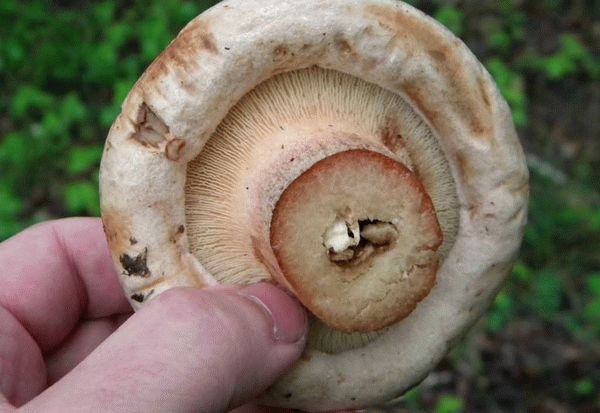

Danger of poisoning even with edible species
Let's start with the fact that edible mushrooms can be harmful to health. This product actively absorbs substances from the environment, the soil on which it grows, the hands that it is harvested. This is how natural vitamins, which mushrooms are rich in, get into the composition, but they also easily turn out there:
- bacteria. They are found everywhere, including in food.Products that have not undergone heat treatment are a direct path to poisoning. The risk group includes pickled mushrooms, the recipe of which does not provide for cooking. And in the case of a lack of salt, such a marinade is harmful to health;
- toxins. Their mushrooms can pick up both during the growth period, being near highways, factories and factories, and in the process of storing the already harvested crop. For example, during a long stay in galvanized dishes.
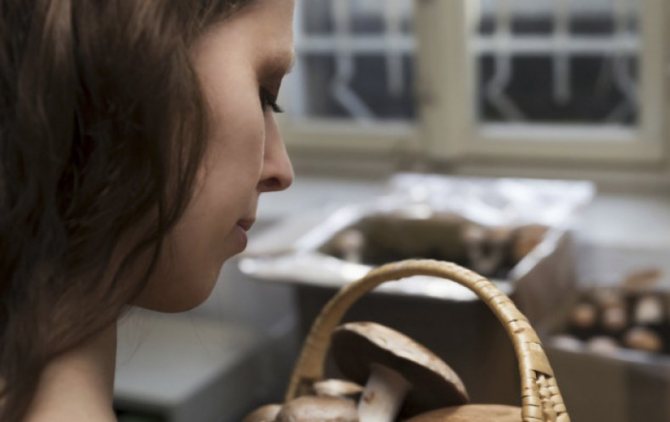

In addition to the harmful composition, they cause poisoning:
- excessive use. It is difficult for the stomach to process such food, so large portions cause disruption of digestive processes. People suffering from chronic diseases in the active phase, the elderly, children, allergy sufferers are especially at risk;
- wormy, spoiled, damaged specimens. Decay products that are poisonous to humans have already appeared in their fruiting bodies;
- mushrooms incompatible with alcohol. Species such as govorushka clavate, gray and porcini mushrooms have a toxin that is absolutely harmless in boiled or pickled form, if not consumed with alcohol. Under its influence, the toxin dissolves, and within an hour the first signs of poisoning appear;
- improperly canned pickles. Undercooked or undersalted pickled mushrooms stored in glass containers quickly deteriorate and harmful bacteria grow in them. This can happen due to a poorly screwed lid.
Basic rules for a mushroom picker
Before going into the forest for mushrooms, you need to familiarize yourself with a number of rules that will help you understand toxicity and edibility.
Forest gifts, which are mortal danger to life, need to be able to recognize by their appearance.
Signs of harmful mushrooms:
- all of them are classified as lamellar. There are non-edible tubular specimens, among which there are no lethal species. You need to be very careful with such mushrooms;
- the family of fly agarics is referred to as poisonous mushrooms. They can be recognized by the tofus at the root of the leg, the ring-shaped collar under the cap;
- summer honey agaric has a thin fringe along the inner border of the cap and a ring inside it. In order not to eat a poisoned product, you do not need to collect mushrooms in the summer months under coniferous trees;
- Fiber patuyara is a mushroom with a very pungent, unpleasant odor, similar to industrial alcohol. His flesh quickly turns red, one has only to break the find.
The forest is full of many other fungi that poison the body, but they do not lead to death.
Be able to distinguish mushrooms similar to each other
Often, inedible specimens are so disguised that even a forester with experience is unable to distinguish between valuable ones.
How to recognize mushrooms for toxicity?
The poisonous, bile satanic mushroom differs from the edible white type of boletus in its pulp: at the break, it acquires a pink or red tint.
The inedible pepper mushroom has a very bitter aftertaste compared to butter dish and flywheel.
A sulfur-yellow, brick-red poisonous honey fungus has no rings on the leg. The color of the plates is not creamy, like that of an edible brother.
The difference between champignon and pale toadstool lies in the plates. Toadstool is white, while mushrooms are pink and brown.
The edible russula differs from the pale toadstool in that it lacks a ring and a volva with tophus on a leg.
Do not collect previously known, life-threatening mushrooms
Toxic products are considered:
- The slender pig is a delayed-effect bomb. It contains an antigen protein that can collect for many years, and then trigger the autoimmune effect of blood clotting. A person dies unexpectedly from heart disease, thrombosis. At the same time, few people will be able to figure out that a long intoxication with a pig was the cause of his death;
- greenfinch includes substances that are not excreted from the body. When accumulated, they lead to a deterioration in the function of the kidneys, muscles, thicken the blood;
- the lines have hydromirine. If you cook mushrooms, even following all the rules, and eat them 2-3 times, you can earn liver and kidney diseases.
Do not collect forestry gifts in industrial areas
It is necessary to collect forest products at a distance of 200 - 300 meters from the road. In the case of a shorter distance, lead from exhaust gases, which accumulates in fungi, settles on the kidneys, bones, and then leads to disability. If the mushrooms have overgrown, or have worms, they are already filled with decay products, the remnants of the activity of the larvae.
No need to trust fictions
Many people believe in some of the existing signs. For example, if a fungus is eaten by insect larvae, it is good. This is a lie, because substances that are not dangerous to insects can be destructive to humans.
Also, if the specimen found tastes good, then it can be consumed. All varieties of amanita are tasty and toxic at the same time.
All young specimens can be eaten without fear for their lives. Often the accumulation of toxins in the body occurs over time. At the same time, toadstool is dangerous from the moment it appears.
If you know how to check the harvested crop, toxic and dangerous trophies will not be present in the basket.
Is it possible to check the degree of edibility "by eye", and what is the risk?
There are many ways of detecting poisonous mushrooms among the people, but such methods are very dubious. Novice mushroom pickers believe that the smell will help in this matter: supposedly harmful varieties have an unpleasant, specific smell.
However, each person perceives aromas in his own way, besides, some edible species also smell unpleasant (for example, ordinary champignon).
Someone believes that insects and worms do not eat poisonous pulp, so they collect only undermined specimens. This is a fundamentally wrong practice with no scientific evidence. In addition, we remember what the use of wormy foods is fraught with.
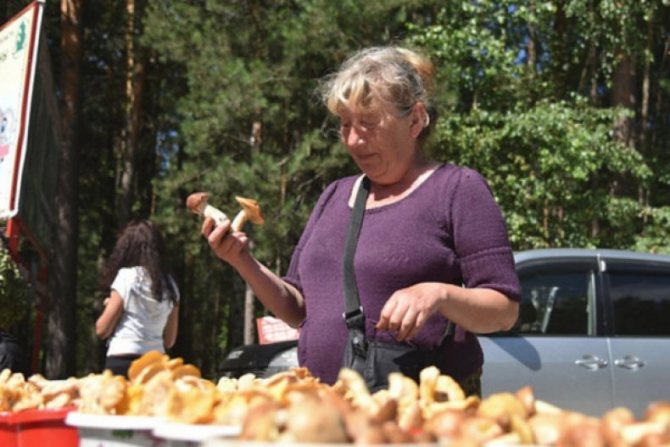

But the most threatening health statement was the thesis that the use of alcohol with mushrooms can neutralize even the most dangerous type of poison. Alcohol does not have such properties, moreover, in some cases it only worsens the situation.
Other myths about self-determining edibility
Many mushroom pickers are still confident that the use of pre-boiling for a long time contributes to the complete removal of poisonous, toxic substances from the mushroom pulp. But, unfortunately, all the most dangerous poisons are heat-resistant, and even a very long boiling does not have any effect on them.
This is interesting: How to make a fish trap with your own hands


When picking mushrooms, novice mushroom pickers are often guided by the smell of the mushroom. It should be noted that the erroneous opinion that a poisonous mushroom necessarily has an unpleasant and specific odor, more often than others, becomes the cause of serious poisoning. For example, the aroma of champignon is almost indistinguishable from the smell of the pulp of the most dangerous, deadly poisonous mushroom - the pale toadstool. Among other things, different people perceive smells very differently and cannot serve as an assessment of the quality and edibility of the mushroom.
There is also an opinion that insects and slugs do not touch the pulp of poisonous mushrooms, which also has no scientific basis. However, the most deadly misconception is the myth that strong alcohol can neutralize mushroom poison, while alcoholic beverages, on the contrary, are almost instantly capable of spreading the toxins of poisonous mushrooms throughout the body.


Folk methods and their effectiveness
Among the folk methods, there are several of the most popular, the effectiveness of which we will now evaluate from a scientific point of view.
Checking with a bow
An onion or garlic is often used to test the edibility. Mushrooms are washed, cleaned and sent in a pot of water to gas.When the water begins to boil, add a few slices of peeled onions or garlic there, and then watch closely.
It is believed that vegetables will turn brownish if poisonous specimens are boiled in a saucepan.
Video: checking mushrooms with onions But in fact, everything is simpler: onions and garlic change color under the influence of tyrosinase, an enzyme that is present in both edible and poisonous mushrooms. Therefore, this method cannot be considered effective.
We use milk
An equally simple and affordable way is to check with ordinary milk. It is believed that if poisonous mushrooms get into the liquid, the milk will quickly turn sour. From a scientific point of view, the statement is unjustified.
Souring is provoked by organic acids, as well as pepsin, an enzyme found in various types of mushrooms, and does not affect their suitability for consumption.
How to test mushrooms with silver
Another myth concerns silver. The folk method says that a silver object thrown into a container with boiling mushrooms will surely darken upon contact with poisonous species.
Video: Testing Mushrooms with Milk and Silver And silver does darken. Only not from poison, but from sulfur in mushroom amino acids.
Vinegar and salt to detoxify mushrooms
Some folk remedies are aimed not at identifying, but at neutralizing the poison. The most popular method in this case involves the use of vinegar and salt.
During the cooking process, it is necessary to add an acetic-salt solution to the mushrooms, and it supposedly destroys the poison. Yes, a similar result is possible with low-toxic species (for example, stitching), but truly poisonous specimens such as fly agaric and pale toadstool do not care about this method.
Basic rules for choosing mushrooms in the forest
When going to the forest after the next rain to harvest, remember that a mushroom picker, like a detective, must take into account a lot of factors, analyze various signs before choosing a worthy replenishment for his basket.
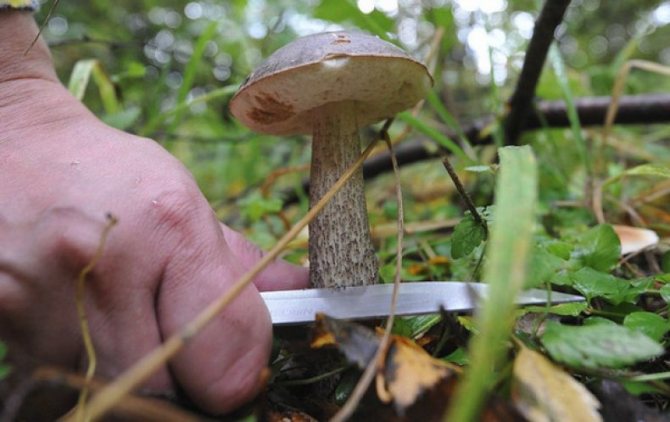

The first thing to remember is:
- deadly poisonous species are actually few, so you need to know them thoroughly. Find out from more experienced colleagues or on the Internet what dangerous varieties grow in your area, and study them in detail. It will not hurt to upload even a photo to your phone, so that at the right time there is an example for comparison;
- dry and hot weather is not the best time for a "quiet hunt";
- do not take overgrown mushrooms (we will discuss the reasons further);
- soak the crop for several hours in regular water before use, changing it periodically to remove more toxins. If possible, try to cook mushrooms, so the likelihood of poisoning is significantly reduced.
Let's consider the basic rules of a real mushroom picker in more detail.
False and real
Anyone who has been involved in mushroom hunting knows that all edible species have poisonous counterparts, from which they are distinguished only by small details. It is these features that a mushroom picker must know in order to harvest a crop that does not harm health.
Read also: Autumn mushrooms: edible, names, which are harvested, photos
Let's look at examples of the most common types:
- White mushroom. Its main feature is a white or beige hat. If you see a mushroom with a red, brown, yellowish cap, do not touch it. You can also break off a piece of the cap. In a real white variety, the place of the fault will not change, but in the satanic mushroom, blue will begin to appear there;
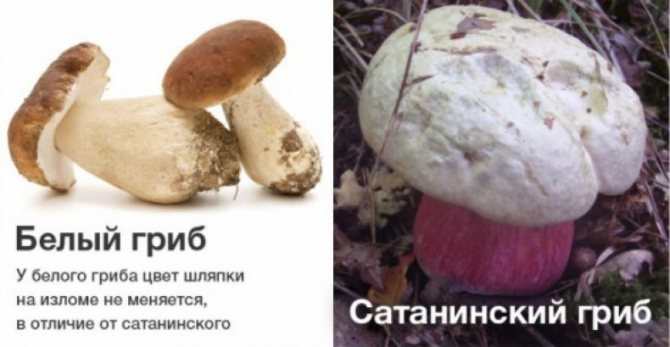

- honey mushroom. It is very easy to make a mistake here if you do not pay attention to the leg in a timely manner. In real honey agarics, a "skirt" stretches from the leg to the cap, as if connecting these parts. Pseudo-agarics have no such "accessory". The second sign is a lamellar cap with scales, which is only found in edible species. Poisonous specimens smell unpleasant and have an unnaturally bright color;


- oiler. Real members of the species are distinguished by a slippery cap and leg. Touching them leaves marks on the fingers, as if from oil, this is especially noticeable in damp cool weather.In sunny times, their skin casts a gloss and easily stretches when removed with a knife. The bottom of the cap resembles a sponge, but the color of edible species may differ.
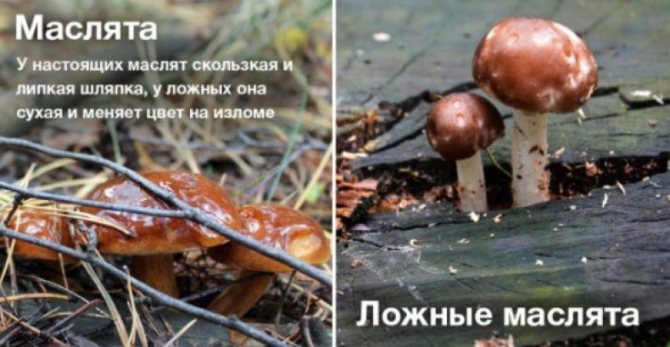

- champignon. Its main counterpart is the poisonous pale toadstool. They are distinguished by mushroom pickers by the skin (in champignons it is smooth, dry, in places scaly), a hat (round in an edible mushroom and slightly flattened in a poisonous one) and plates under it. In the champignon, they darken from touch, and in the toadstool they do not react in any way. On the leg of an edible specimen, you can see a light film at the base, which the pale toadstool cannot boast of. In addition, these comrades prefer a different environment: the champignon grows in open places, forest edges, marshy meadows, in vegetable gardens, while the poisonous twin lives in the shade of deciduous forests;
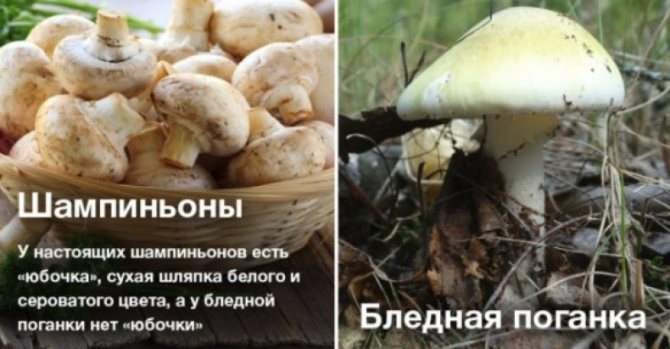

- birch tree. Here it will be more difficult to decide on an insidious double. The first sign: a clean rim. Usually, false boletus trees have a bitter taste, so insects and worms avoid them. Second symptom: clean leg. It should have a pattern that resembles a birch bark. If it is missing, or if there are streaks that look like blood vessels, discard such a copy. The third sign: a greenish or brown shade of the cap, which casts pink from below. A real birch tree does not possess such flowers. The fourth sign: the rim of the cap. If a velvety surface is felt under the fingers, this is bad, because the edible has a smooth surface. And finally, break the flesh - a brown birch tree will have a scrap white, not pink;
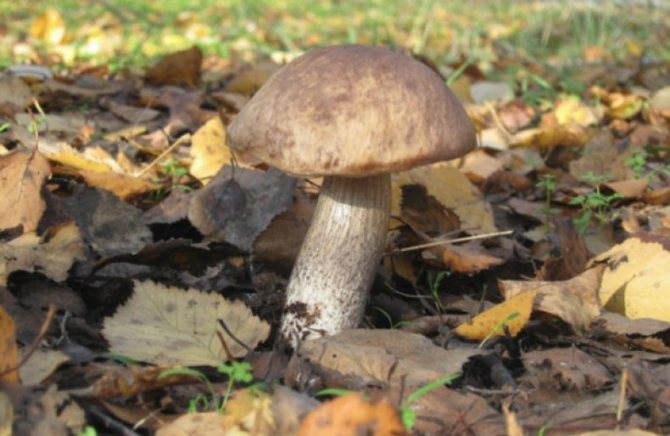

Edible boletus
- boletus. It is rarely confused with other species, but among its counterparts, the bitter mushroom (gall fungus) is closest to it. In contrast, the boletus does not grow in coniferous forests, has a mesh pattern on the leg, its tubular layer casts pink, and the flesh after cutting gradually changes color from white to pink. And the bile double always looks beautiful, neat, so experienced mushroom pickers avoid it.


Gorchak (gall mushroom)
The right place: not to pick mushrooms
Although mushrooms can grow almost anywhere, this does not mean that at the same time they can be collected everywhere. It must be remembered that this culture greedily absorbs substances from the environment, and try to avoid:
- roads. Exhaust gases are not the best supplement for human health, therefore, we move away from large highways into the forest for at least a kilometer, and from a regular highway it will be enough for 500 m;
- railway tracks;
- factories and plants;
- oil storage and fuel depots;
- garbage dumps;
- agricultural enterprises (when growing their products, they can use chemicals and pesticides, which are transmitted through the soil to mushrooms growing nearby).
Overgrown mushrooms
A separate risk group is represented by old specimens of edible varieties. Even growing in safe areas, they are able to accumulate enough heavy metals and harmful components for a long time to spoil a person's health. For this reason, try to collect only young growth.
But if it was not possible to avoid overgrowths, then boil them for at least 20 minutes before using. After that, the water must be drained, and only then the mushrooms will be ready for further processing.
Examples of pseudo-fighters
Unfortunately, such a noble mushroom as boletus has a considerable number of dangerous twins. In order not to make a mistake when collecting and not endanger health, it is necessary to consider them in more detail.
Bilious
Because of the bitter taste, this species is popularly called gorchak. According to the description, the gall fungus has the following characteristics:
- inedible;
- the yellow-brown cap of the gall mushroom has the shape of a semicircle, its diameter is 5-15 cm;
- the leg is cylindrical, 3-15 cm high, the thickness reaches 3 cm;
- the pulp is dense, with distinct fiber, the aroma is weak;
- tubular hymenophore (spongy);
- the spore powder has a pink color, at the site of the break or cut, the pulp turns red;
- there is a characteristic brown mesh on the surface of the leg, forming a beautiful pattern.
Boletus is beautiful


Poisonous mushrooms can cause severe poisoning
It is often called beautiful-legged for the characteristic color of this part of the fruiting body. Despite its attractive name, this porcini mushroom counterpart is inedible due to its very bitter taste. His bitterness is not removed even after prolonged cooking.
Among the main characteristics are the following:
- the cap is large (up to 25 cm), semicircular, its surface is velvety and dry, the color is from light to dark brown;
- the leg is high (up to 10 cm), dense and thick, the fruiting body grows up to 15 cm;
- the lower spongy side of the cap (hymenophore) has a deep yellow color;
- the pulp is firm, yellowish, with an unpleasant odor;
- there is a fine mesh on the leg;
- the place of the cut acquires a blue tint.
():
- The boletus boletus is widespread only in the southern part of Russia, where it is found in mountainous terrain. It forms mycorrhiza with representatives of conifers.
- In young mushrooms, the pulp has a sweetish taste, in adults it is extremely bitter. There is no smell.
- The color of the stem changes from the cap to the surface of the soil: from greenish-yellow to red or dark red. But the very base of the leg is white.
- The original coloration of the leg in older specimens may fade.
- On the surface of the leg there is a fine mesh: in the upper part it is white, in the middle of the leg it is red.
Opinions differ on the toxicity of the beautiful leg pain. The disputing parties agree on one thing: there are no deaths as a result of poisoning with this species. But in any case, you need to follow the safety rules.
Satanic
Outwardly similar to white, but in fact, poisonous satanic mushroom grows in oak and birch forests. It is an increased source of danger to human health: by eating even 20-30 g of the product, you can get severe poisoning. Its description includes the following signs:
- a large-sized hat (up to 40 cm), pillow-shaped, dense and smooth, brown with an olive tint;
- the underside of the cap is spongy, pink;
- the leg is cylindrical, tapers downward;
- the color of the leg is very peculiar: in the upper part - red-yellow, in the center - red-orange, below - yellow-brown;
- the mushroom grows to a height of 13-15 cm;
- the cut initially turns blue, and then becomes red, which is associated with the oxidation of poisonous compounds by oxygen.
Speckled oak
This mushroom is classified as conditionally edible: with proper heat treatment, it is suitable for human consumption. It looks like a boletus and has the following characteristics:
- the cap is large (up to 20 cm), pillow-shaped, the surface is velvety and dry, the color is brown with a reddish tint;
- the leg reaches a height of 10 cm, has a tuberous shape;
- when pressed on the light edge of the cap and leg, the mushroom darkens;
- the cut on the pulp acquires a blue tint after a while.
Prefers acidic soils. It is rarely found on the territory of Russia. The first fruiting bodies appear in mid-May. You can harvest until the end of October. Yields peak in July.
Borovik le Gal
Its second name is legal boletus. This is another type of poisonous false porcini mushrooms, which are characterized by the following features:
- the cap is large (up to 16 cm), curved, with a smooth pink-orange surface;
- the mushroom has a pleasant aroma;
- the pulp is milky with a yellowish tinge;
- the leg is strong, thick, reaches 5 cm in diameter, grows up to 15-17 cm in height;
- the color of the leg reproduces the color of the cap;
- a red mesh forms on the leg in its upper part;
- the color of the pulp is white or yellow, it turns blue on the cut.
The species prefer alkaline soils. Fruiting bodies can be found in the forest in summer and early autumn.


